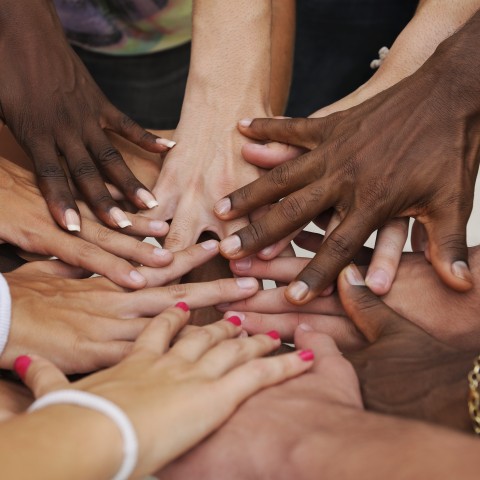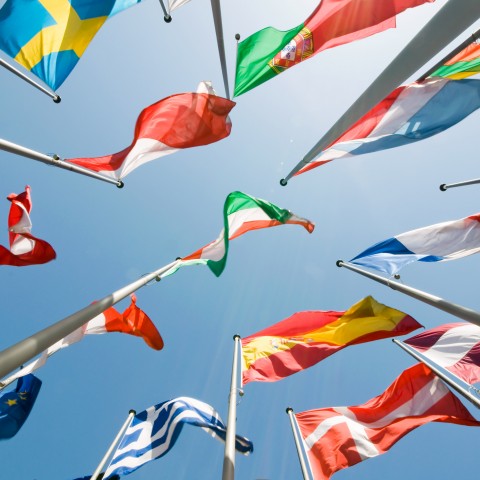
The Filipino nationality always draws attention. Everywhere they go, Filipinos make a name for themselves, globally and in different industries—thus the term “Filipino pride.” Pride for one’s nationality is not exclusive to Filipinos though. Regardless of your race, when you visit another country, you are always excited to let everyone know where you are from and what your nationality is. The question, however, is whether you know how to introduce yourself in a way that will impress your listeners.
If you’re visiting the Philippines, for instance, a really good way to pique someone’s interest is to let them hear you introduce yourself in Tagalog. That’s what this guide is for. In this blog post, you’ll learn how to ask someone their nationality, how to tell someone what your nationality is, and what common patterns you can use to do so—all in Filipino, of course!

It’s important to have pride in one’s nationality.
 Table of Contents
Table of Contents
- Different Nationalities in the Philippines
- How Do You Ask Someone Their Nationality in Filipino?
- How Do You Tell Someone Your Nationality in Filipino?
- Sentence Structure to Use When Talking About Your Nationality in Filipino
- How FilipinoPod101 Can Help
1. Different Nationalities in the Philippines
1 – Major Ethnolinguistic Groups in the Philippines
Before we proceed to learn how to talk about one’s nationality in Filipino, let’s first explore the different nationalities in the Philippines. While the Philippines is considered one nation, it is made up of over a hundred ethnolinguistic nations—175 to be exact. As an archipelago, the Philippines is composed of 7,640 islands and 18 regions. Each of these regions is represented by different ethnolinguistic groups. The Tagalogs are the largest of these groups, most of whom live within the National Capital Region. The Cebuanos, who inhabit the islands of Cebu, Siquijor, and Bohol, come second.
Here’s an overview of the largest ethnolinguistic groups in the Philippines today.
| Ethnolinguistic Group | Population | Region |
| Tagalog | 30,000,000 | NCR, Calabarzon |
| Cebuano | 9,125,637 | Central Visayas |
| Ilocano | 8,074,536 | Region I (Ilocos Region) |
| Hiligaynon | 7,773,655 | Region VI (Western Visayas), Soccsksargen Region |
| Bicolano | 6,299,283 | Region V (Bicol Peninsula) |
| Waray | 3,660,645 | Region VIII (Eastern Visayas) |
| Zamboangueño | 367,278 | Region IX (Zamboanga Peninsula) |
| Kapampangan | 2,784,526 | Region III (Central Luzon) |
| Pangasinense | 1,823,865 | Region I (Ilocos Region) |
| Surigaonon | 367,278 | Region XIII (Caraga Region) |
Most of the people from each of these regions can understand and speak Filipino or Tagalog. However, not everyone can understand or speak each other’s local dialects. It’s also not unusual for non-native Tagalog speakers to have their own accent when speaking in Tagalog.
2 – Top Nationalities Visiting the Philippines Every Year
This time, let’s find out which countries the Philippines receives the most visitors from each year. The data below is from 2019, but it should show which countries consider the Philippines a top tourist destination. As you can see, South Korea and China are at the top of the list. They are followed by the United States, Japan, and Taiwan. The country received 8 million tourists in 2019 and currently ranks 51st in the world in terms of tourist numbers.
| Country | Visitor Arrival (2019) | Nationality (English) | Nationality (Filipino) |
| Philippines | – | Filipino | Pilipino |
| South Korea | 1,989,322 | Korean | Koreano |
| China | 1,743,309 | Chinese | Tsino/Intsik |
| United States | 1,064,440 | American | Amerikano |
| Japan | 682,788 | Japanese | Hapon |
| Taiwan | 327,273 | Taiwanese | Taiwanese |
| Australia | 286,170 | Australian | Australyano |
| Canada | 238,850 | Canadian | Canadian |
| United Kingdom | 209,206 | British | Briton |
| Singapore | 158,595 | Singaporean | Singaporean |
| Malaysia | 139,882 | Malaysian | Malay |
| India | 134,963 | Indian | Indiyano |
| Germany | 103,756 | German | Aleman |
| France | 88,577 | French | Pranses |
| Spain | 49,728 | Spanish | Espanyol |
| Russia | 36,111 | Russian | Ruso |

The thousands of tourists visiting the Philippines each year are a testament to the beauty of the country and the hospitality of its people.
- ➜ Here at FilipinoPod101, we have lessons to help you learn words and phrases related to tourism!
2. How Do You Ask Someone Their Nationality in Filipino?
The Filipino word for “nationality” is nasyonalidad. In the Philippines, when people want to ask about one’s nationality, they either use this word or the Filipino word for “race,” which is lahi. The word dugo or “blood” is also used from time to time. And, since Filipino has both formal and informal speech, it makes sense to learn how to ask someone their nationality in both formal and informal Tagalog.
1 – Formal
It’s not all the time that you’ll encounter a Filipino using formal speech or need to use formal speech yourself. Nevertheless, it’s still essential to familiarize yourself with it. When we speak of formal Filipino, the difference is usually in the types of words used. For instance, instead of saying ipinanganak (“was/were born”), we use isinilang. And, instead of saying pwede (“can”), we use maaari. Let’s see a few examples to understand how this works:
- Maaari mo bang sabihin kung ano ang iyong nasyonalidad?
(“Can you tell what your nationality is?”)
- Maaari bang malaman kung saang bansa ka nanggaling?
(“May I know which country you are from?”)
- Saang bansa ka isinilang?
(“What country were you born in?”)
- Ikaw ba ay isang [nationality]?
(“Are you [nationality]?”)
- Ikaw ba ay may lahing Portuges?
(“Do you have Portuguese blood?”)
- Nais ko po sanang malaman kung ano ang nasyonalidad ninyo.
(“I was wondering if you could tell me what your nationality is.”)
(Literally: “I would like to know what your nationality is.”)
2 – Informal
Another thing that separates informal Filipino from formal Filipino is that it’s often straightforward and may or may not include polite introductory words. That makes the sentences significantly shorter.
- Ano ang nasyonalidad mo?
(“What is your nationality?”)
- [Nationality] ka ba?
(“Are you [nationality]?”)
*Notice that this translates the same way that the formal Ikaw ba ay isang [nationality]? does, but it is less formal and more direct.
- Sa Pilipinas ka ba lumaki?
(“Did you grow up in the Philippines?” / “Were you raised in the Philippines?”)
- Sa aling bansa ka galing?
(“Which country did you come from?”)
(Literally: “In which country did you come from?”)
- Mayroon ka bang lahing Kastila?
(“Do you have Spanish blood?”)

Mayroon ka bang lahing Kastila? (“Do you have Spanish blood?”)
- ➜ How does formal Filipino work? This video lesson will teach you everything you need to know about the subject.
3. How Do You Tell Someone Your Nationality in Filipino?
Talking about your nationality in Tagalog is relatively easy. If you’re comfortable discussing the subject of race or ethnicity with a Filipino friend, here are some sentence patterns you can follow:
- Sa Amerika ako ipinanganak.
(“I was born in America.”)
- Ang aking pagkamamamayan ay Singaporean.
(“My citizenship is Singaporean.”)
- Isa akong Griyego.
(“I am Greek.”)
- Australyano ako, pero sa Inglatera ako lumaki.
(“I am Australian, but I grew up in England.”)
- Dito ako sa Pilipinas ipinanganak, pero sa Dubai na ako lumaki.
(“I was born here in the Philippines, but I spent most of my life in Dubai.”)
- Dual citizen ako ng Amerika, pero isa akong Thai.
(“I’m a dual citizen of America, but I am Thai.”)
- Ruso ako.
(“I am Russian.”)
If you don’t want to talk about your nationality, you can respectfully decline using the following phrases:
- Pasensya ka na pero ayaw kong pag-usapan ang mga ganitong paksa.
“I’m really sorry, but I don’t want to talk about these kinds of topics.”
- Ibang bagay na lang ang pag-usapan natin kung maaari.
“Let’s just talk about something else, if possible.”
- Pwede ba nating baguhin ang paksa?
“Can we change the subject, please?”

Dito ako sa Pilipinas ipinanganak, pero sa Dubai na ako lumaki. (“I was born here in the Philippines, but I spent most of my life in Dubai.”)
- ➜ Knowing how to ask questions and respond to them can help you build your rapport with the right people. Here are 10 fundamental questions and answers in Filipino you should be familiar with.
4. Sentence Structure to Use When Talking About Your Nationality in Filipino
Earlier, we listed the top nationalities visiting the Philippines each year. In this section, we’ve expanded that list to include the capital city and primary language of each country.
From this list, you can develop a basic pattern for speaking about your nationality in Filipino.
| Country | Nationality (Filipino) | Capital City | Language(English) | Language(Filipino) |
| Philippines | Pilipino | Manila | Filipino | Pilipino |
| South Korea | Koreano | Seoul | Korean | Koreano |
| China | Tsino/Intsik | Beijing | Mandarin | Mandarin |
| United States | Amerikano | Washington, D.C. | English | Ingles |
| Japan | Hapon | Tokyo | Japanese | Hapones |
| Taiwan | Taiwanese | Taipei | Mandarin | Mandarin |
| Australia | Australyano | Canberra | English | Ingles |
| Canada | Canadian | Ottawa | English | Ingles |
| United Kingdom | British | London | English | Ingles |
| Singapore | Singaporean | Singapore | Malay | Malay |
| Malaysia | Malay | Kuala Lumpur | Malay | Malay |
| India | Indiyano | New Delhi | Hindi | Indiyano |
| Germany | Aleman | Berlin | German | Aleman |
| France | Pranses | Paris | French | Pranses |
| Spain | Espanyol | Madrid | Spanish | Espanyol |
| Russia | Ruso | Moscow | Russian | Ruso |
Using the data above, let’s construct a self-introduction that you can use to tell someone what your nationality is. Let’s start with the most common pattern, where you first mention which country you came from.
- Taga Australia ako.
(“I am from Australia.”)
Next, you can mention what your nationality is.
- Isa akong Australyano.
(“I am an Australian.”)
You can also mention which city you live in.
- Nakatira ako sa Canberra.
(“I live in Canberra.”)
After which, you can mention what language you speak.
- Ingles ang pangunahing wikang gamit ko.
(“English is my native language.”)
If you know other languages, you can mention that too.
- Marunong din akong mag-Mandarin.
(“I also know how to speak Mandarin.”)
Putting all of these together, you get the following sentence:
- Isa akong Australyano. Nakatira ako sa Canberra. Ingles ang wikang gamit ko pero marunong din akong mag-Mandarin.
(“I am an Australian. I live in Canberra. English is the primary language I use, but I also know how to speak Mandarin.”)
The following are various other ways to talk about your nationality and the language (or languages) you speak in Filipino.
- Pilipino ako. Ipinanganak ako sa Maynila. Ang wikang gamit ko ay Tagalog.
(“I am a Filipino. I was born in Manila. The language I use is Tagalog.”)
- Koreano ako na lumaki sa Seoul, pero Filipino citizen ako, at marunong akong magsalita ng Ingles at Pilipino.
(“I’m a Korean who was raised in Seoul, but I’m a Filipino citizen, and I know how to speak both English and Filipino.”)
- Amerikano ako, pero sa London na ako namalagi mga dalawang dekada na.
(“I’m an American, but I have been residing in London for two decades now.”)
- Sa New Zealand ako lumaki at namalagi ng mahabang panahon, pero mayroon akong pasaporte ng Pilipinas dahil Pilipino ako.
(“I grew up in New Zealand and lived there for a long time, but I do have a Philippine passport since I am Filipino.”)
- Isa akong Taiwanese. Hindi pa ako masyadong marunong mag Tagalog.
(“I’m Taiwanese. I’m not that fluent in Tagalog yet.”)
- Ang aking mga ninuno ay nagmula sa Tsina, partikular sa Beijing.
(“My ancestors came from China, specifically Beijing.”)
- Singaporean ako na lumaki sa Australia. Marunong akong mag Mandarin at Malay.
(“I’m a Singaporean who grew up in Australia. I am fluent in both Mandarin and Malay.”)
- Pilipino ang tatay ko at Haponesa naman ang nanay ko. Marunong akong magsalita ng Tagalog at Hapones.
(“My dad is Filipino and my mom is Japanese. I know how to speak both Filipino and Japanese.”)
- May lahi akong Pranses at Kastila. Nag-aaral pa lang akong magsalita ng Pilipino.
(“I am of French and Spanish descent. I’m just learning to speak Filipino.”)
- Ayon sa birth certificate ko, sa Ehipto ako ipinanganak. Pero Pilipino talaga ako, at magaling akong mag-Tagalog.
(“According to my birth certification, I was born in Egypt. But I am Filipino, and I can speak Tagalog very well.”
- Sa Moscow ako ipinanganak at lumaki. Ruso ang aking ama at Malay naman ang aking ina.
(“I was born and raised in Moscow. My father is Russian, and my mother is Malay.”)
- Pilipino ako, pero mayroon akong dugong Pranses at Aleman sa panig ng aking ina.
(“I am Filipino, but I have French and German ancestry on my mother’s side.”)
- Swedish ako, pero meron akong Philippine citizenship.
(“I am Swedish, but I have Philippine citizenship.”)

May lahi akong Pranses at Kastila. (“I am of French and Spanish descent.”)
- ➜ Learning how to tell others what your nationality is in Filipino is vital if you wish to communicate like a native. Just as important is learning these 10 basic lines for self-introduction.
5. How FilipinoPod101 Can Help
In this guide, you’ve learned how to say the names of different nationalities in Filipino as well as how to talk about your nationality when introducing yourself. Are there other names of countries and nationalities that you wish had been included here? Let us know in the comments section below!
Before you leave, don’t forget to check out the rest of our blog entries and lessons. Here at FilipinoPod101, you’re sure to find a lesson that’s tailored to your learning needs, whether you’re at the beginner level, intermediate level, or advanced level.
We have free resources and lessons for you to begin with. Video and audio lessons are available so that you don’t just read but also hear how Filipino words are pronounced. We also have slideshows, wordlists, and flashcards designed to help you learn vocabulary words by heart.
And if you want to take things to another level, our MyTeacher service is here for you. Available with a Premium PLUS subscription, MyTeacher provides you with a personal teacher who will give you real-time feedback and guidance so that you can speak fluent Filipino in no time!










